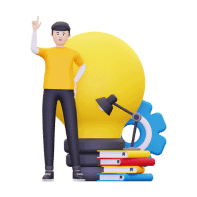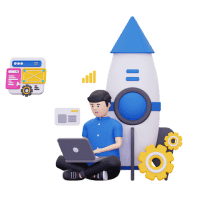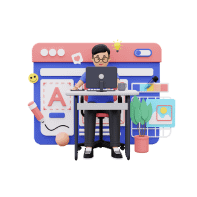Free Plus Shipping Funnel
Type
Sell Products
Pages
5
Times
5-7 Days
Difficulty
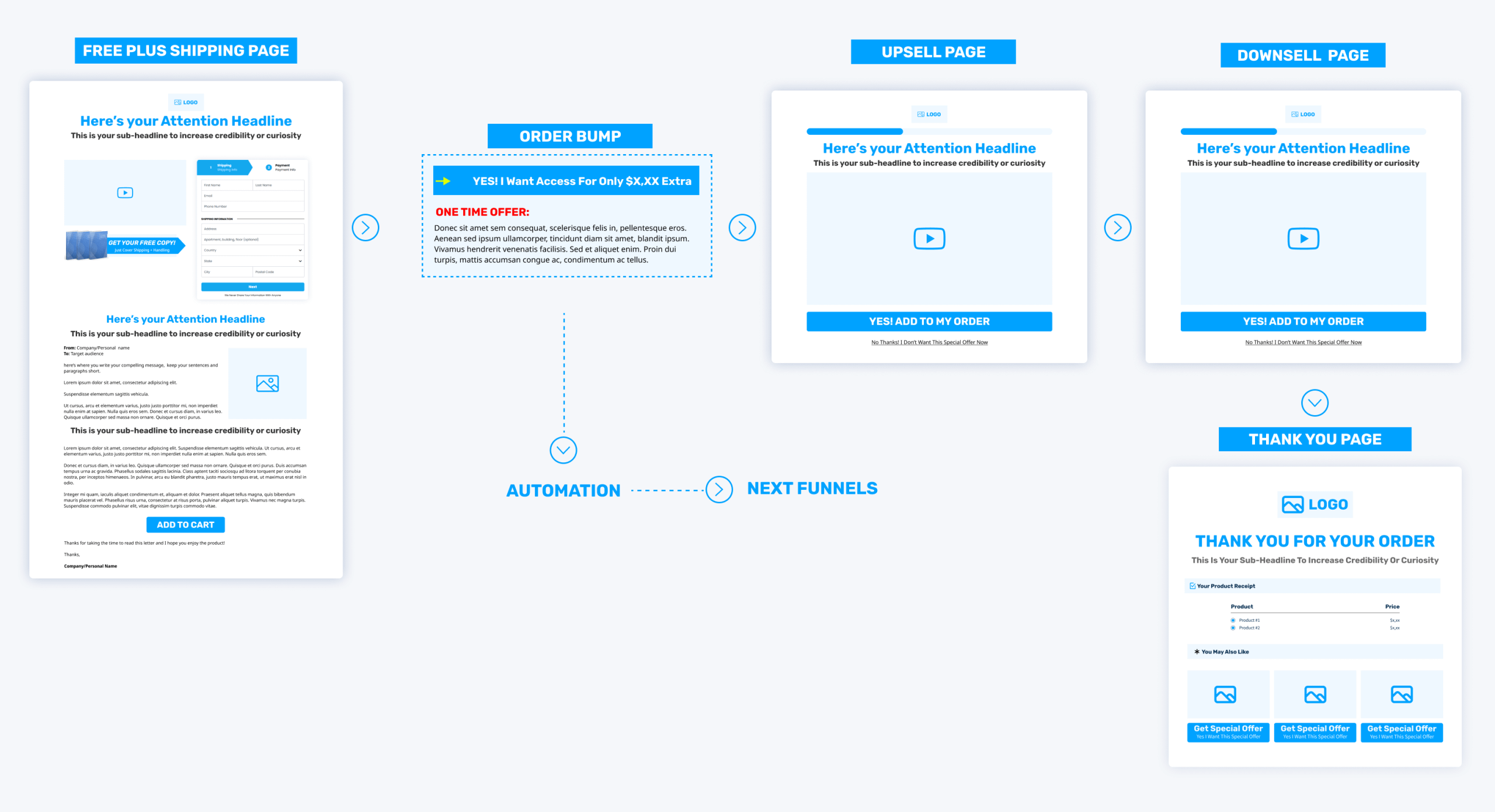
15 RESOURCES
BEST REVIEW
Build Your Ecom Or Expert Business in Just 30 Days…
Join the brand-new One Funnel Away Challenge with live training and support. $11,191 worth of value.
Definition: A Free Plus Shipping Funnel is a type of sales funnel that uses a free plus shipping offer. You give away a product for free, and the customer pays only for shipping (usually $7.95–$19.95). You don’t make money from the free item. You make money when they adds more items at checkout (this is called an “order bump”) or buys more expensive items later (this is called an “upsell”).
Are you a coach aiming to sell your expertise, a small business owner trying to scale your operations, or a marketer creating funnels for clients?
In that case, you may be dealing with low conversion rates and high customer acquisition costs.
Free plus shipping funnels can address both issues by reducing purchase resistance while maximizing customer value. This strategy helps attract more customers by lowering the barrier to entry and increasing the likelihood of lead generation and sales.
Additionally, free plus shipping funnels can help increase visibility within a niche and build brand awareness.
In this guide, you’ll learn the exact psychology behind why “free” converts so well, how to structure your funnel pages for maximum profit, and the specific tools and strategies that work.
I’ll show you real examples from million-dollar funnels and help you avoid the costly mistakes that kill most beginners’ profits.
What exactly is a free plus shipping funnel, and how does it work?
Let me break it down for you.
What is a Free Plus Shipping Funnel?
The free plus shipping funnel is a marketing strategy used to attract customers by offering products for free while charging only for shipping, making it especially effective for eCommerce startups looking to test different products and maximize profitability.
A Free Plus Shipping Funnel sits at stage 2 of the value ladder as a front-end offer.
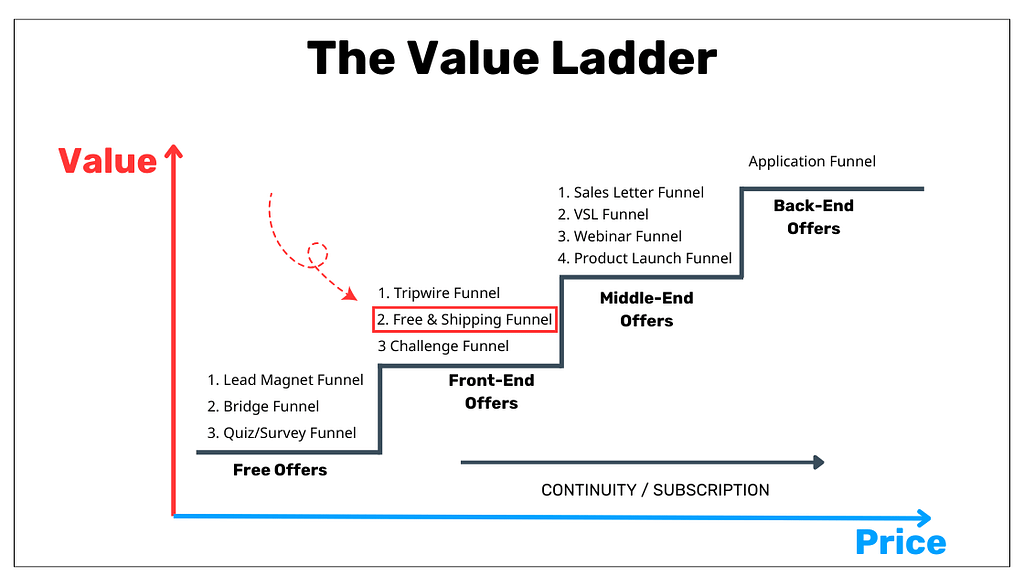
Unlike a regular Tripwire sales funnel that sells low-priced products, this funnel gives away physical item completely free. People only pay $7.95 to $19.95 for shipping and handling.
The business model works because you don’t make money from the free physical product itself. Instead, revenue comes from strategic order bumps at checkout and higher-priced upsells after purchase.
Here’s how a typical free plus shipping model works:
- Jim sees a Facebook ad for a free Keto Jump Start DVD. He clicks through to a landing page that highlights the DVD’s value.
- After entering his shipping address and paying $9.95 for delivery, he encounters an order bump for a Keto Meal Plan for $19, which he adds to his order.
- On the next page, he is offered a supplement at a 20% discount—$50 for one bottle or $127 for three bottles (a 37% discount).
- Following this, he is presented with the option to enroll in the Advanced Program, which offers six months of full immersion for $67.
- If he decides to skip this offer, he will receive a downsell option for the same program, available at two payments of $35.
What makes this different from regular sales funnels?
Tripwire funnels or Video Sales Letter Funnels ask for money up front. That scares people. But Free plus shipping feels safe because the product is “free.”
The free product in a free plus shipping funnel often serves as a bait to generate leads for future sales.
People think:
“It’s free, so why not try it?”
This psychological shift transforms skeptical browsers into eager buyers.
Successful free plus shipping funnels require identifying products that the target market values highly. The best products for this model have a high perceived value but a low actual cost. Books are ideal—while they only cost $2-3 to print, they feel valuable. Small accessories, sample supplements, and digital products on physical media also perform well.
For example, if you’re an author, consider giving away a book. Coaches and course creators can offer a DVD or a USB that contains your course training materials.
The key is to find items that have a low cost but offer high value to your target audience. While you won’t profit from shipping costs, you can upsell and promote additional products as customers move up the value ladder.
Understanding why this model works so well requires diving into the psychology of free plus shipping offers.
Why Does The Free Plus Shipping Funnel Work?
Free plus shipping funnels strike the perfect balance between completely “free” lead magnet funnel and tripwire funnels.
Instead of asking people to pay $10–$20 for a product, you give it away for free. The only thing they pay for is shipping, usually around $7.95–$12.95.
This small change creates a massive psychological difference.
Let’s say you’re selling a book on Amazon for $20. Prospects wrestle with value questions:
- “Is it worth the money?”
- “Maybe I should read reviews.”
- “What if it’s not good?”
But when you offer that same $20 book for FREE plus $9.95 shipping, their internal dialogue completely changes.
Now they think,
“It’s free, so why not try it? I’m only risking the shipping cost.”
This is a great free offer because the perceived value is high and the risk is low, making it very appealing.
Adding bonuses like videos, templates, or training makes the offer even stronger. Now it feels like $300 in value for under $10. That’s an easy “yes” and no-brainer for most people.
Choosing the perfect free product for your funnel is key—look for something that maximizes perceived value and fits your audience’s needs.
The key word FREE in your marketing is what grabs attention and drives action. It’s a powerful trigger that encourages upsells and increases the perceived value of your offer, whether it’s free products or shipping.
A successful free plus shipping funnel is built on strategic planning, strong marketing, and solid economics. When these elements come together, your funnel becomes a powerful lead magnet and conversion tool.
The original price ($20 or more) stays in their mind, so $9.95 feels like a great deal.
There’s another effect too.
When people pay even a small amount, they value the product more. They’re more likely to open it, read it, and use it. That means they’re more likely to buy from you again.
Free offers also spread faster. People love sharing good deals. They tell friends, post online, and leave happy reviews. This creates trust and brings more new customers. Over time, this strategy helps build your brand and makes your business more recognizable and trusted in the market.
And finally, when you give something valuable for free, people feel thankful. They want to give back. That’s why a free book often leads to big sales later.
5 Essential Pages Of A High-Converting Free Plus Shipping Funnel?
Here are 5 Essential pages of a free plus shipping funnel:
- Free plus Shipping landing page (sales page)
- Checkout page + order bump
- Upsell page
- Downsell page (optional)
- Thank you page
Well-designed landing pages are crucial for guiding customers through the funnel and increasing conversions.
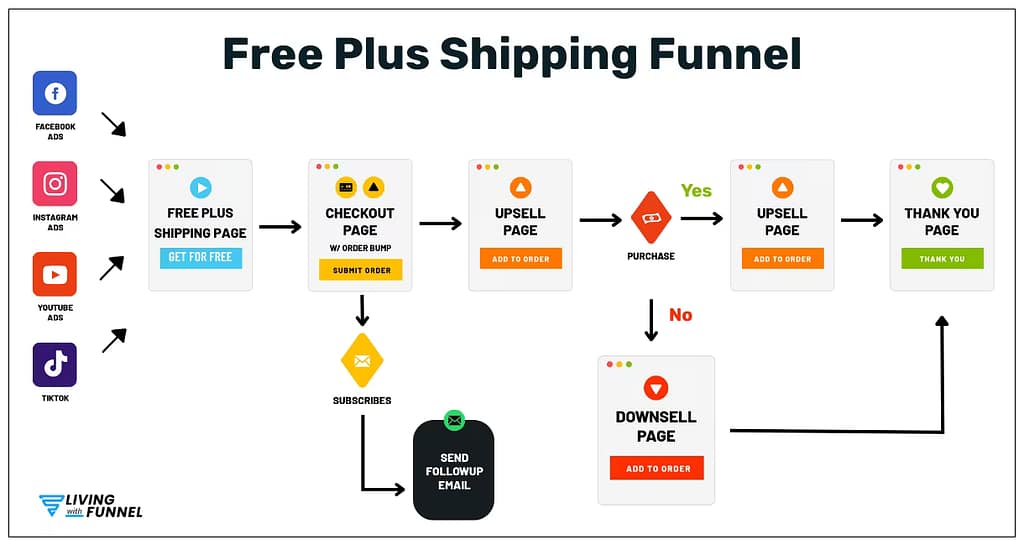
To demonstrate how this funnel works, I’m going to walk you through Dean Graziosi’s “Millionaire Success Habits” book funnel.
Dean Graziosi is a multiple New York Times best-selling author, entrepreneur, and investor. He started or played a major role in over 14 successful companies. His frameworks have generated over $2 billion in sales.
Each page serves a specific conversion purpose and includes proven elements that maximize profitability, as demonstrated by this legendary funnel. The final step, the delivery page, is where customers access their purchased product, completing the customer journey.
1. Free Plus Shipping Offer Landing Page
Dean Graziosi’s landing page teaches us exactly what converts.
At the top of the page, he hooks us with the subheadline:
”There Are 1,700 New Millionaires Created Every Day In America Alone…Could You Be Next?”
This taps into possibility and FOMO simultaneously.
The main headline delivers the offer clearly:
“Get Your FREE Hardcover Copy Of Millionaire Success Habits! Only While Supplies Last!”
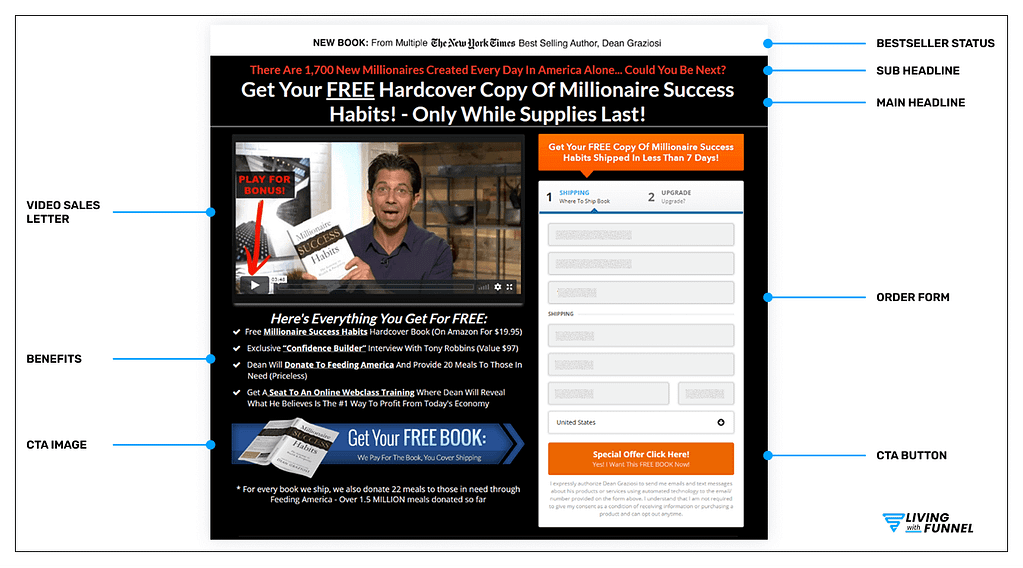
Social proof dominates the page strategically.
The book’s New York Times Bestseller status appears prominently: “NEW BOOK: From Multiple New York Times Best Selling Author, Dean Graziosi.
Three testimonial sections build trust progressively.
Section 1: Features industry giants like Tony Robbins, Richard Branson, Larry King, and Russell Brunson.
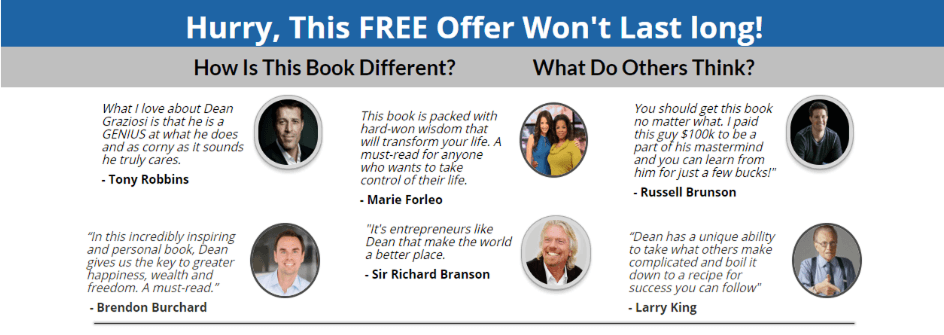
Section 2: Shows real Amazon reviews.
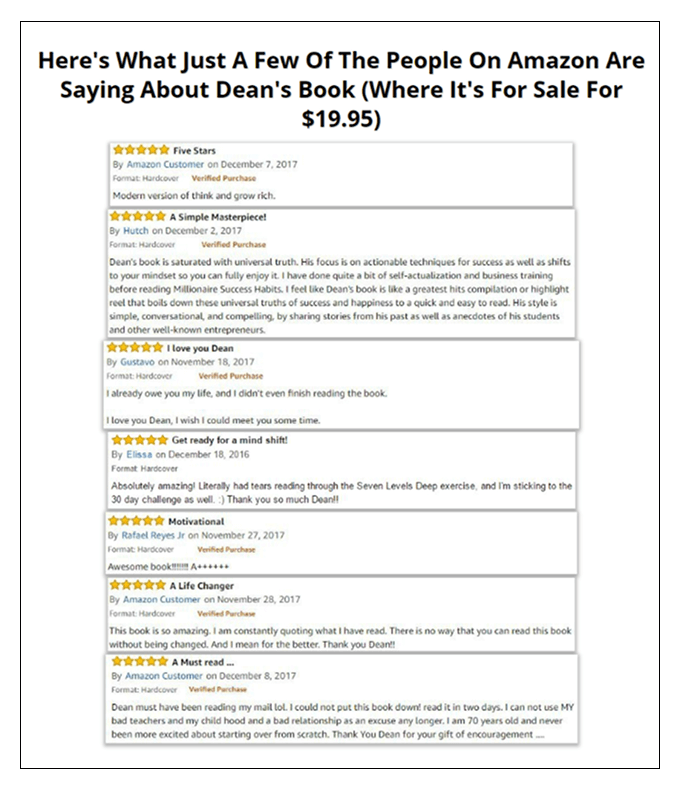
Section 3: Includes transformation stories from Dean’s students.
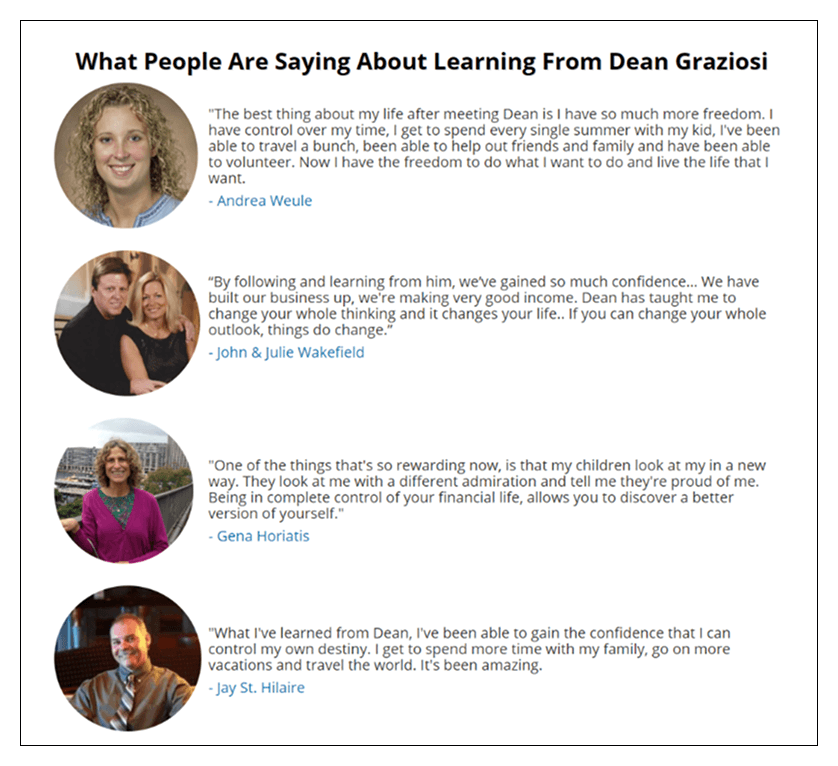
Urgency elements appear naturally throughout. “Hurry this free offer won’t last long” creates time pressure without feeling pushy. The professional book imagery and author photos establish instant credibility.
It’s also important that the landing page is visually appealing. A visually appealing design increases engagement and encourages more conversions by making the offer stand out and keeping visitors interested.
But here’s what makes this page convert – the irresistible offer stack. Dean doesn’t just give away a book. He offer visitors:
- A free Millionaire Success Habits hardcover
- “The 5 Best Ways To Make Money” training
- Exclusive Tony Robbins interview
- 20 meals donated to Feeding America per order
- Access to Better Life Challenge with a chance to win Dean’s Tesla
- Online webclass training.
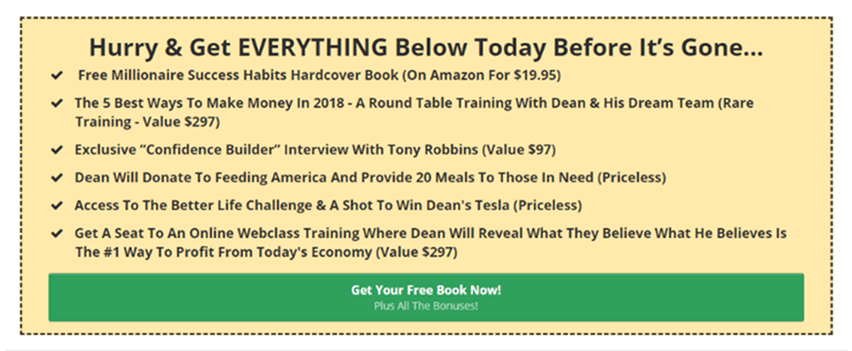
The call-to-action combines imagery and text perfectly. “Get Your FREE Book – We Pay For Your Book, You Cover Shipping” appears as an image element.
The button reads “Special Offer Click Here – Yes I Want This FREE BOOK Now!”
💡 The key takeaway? If your page doesn’t convert well, your offer needs work. Without bestseller status like Dean’s, focus on creating an irresistible offer that your audience can’t refuse.
2. Checkout Page Optimization + Order Bump Strategy
Dean’s checkout strategy maximizes conversions through smart design. Instead of directing visitorss to a separate checkout page, Dean Graziosi employs a two-step order form on the same page, which helps reduce friction and minimize abandonment.
Step one simply asks “Where To Ship Book?” Once prospects fill out shipping details and email address, they move to step two. Only then do they see credit card fields for the shipping and handling charge. At this stage, the money details, such as shipping costs, are revealed to maintain engagement and prevent early drop-off.
Selecting the right shipping method during checkout is also crucial, as it can optimize conversions and maximize profitability.
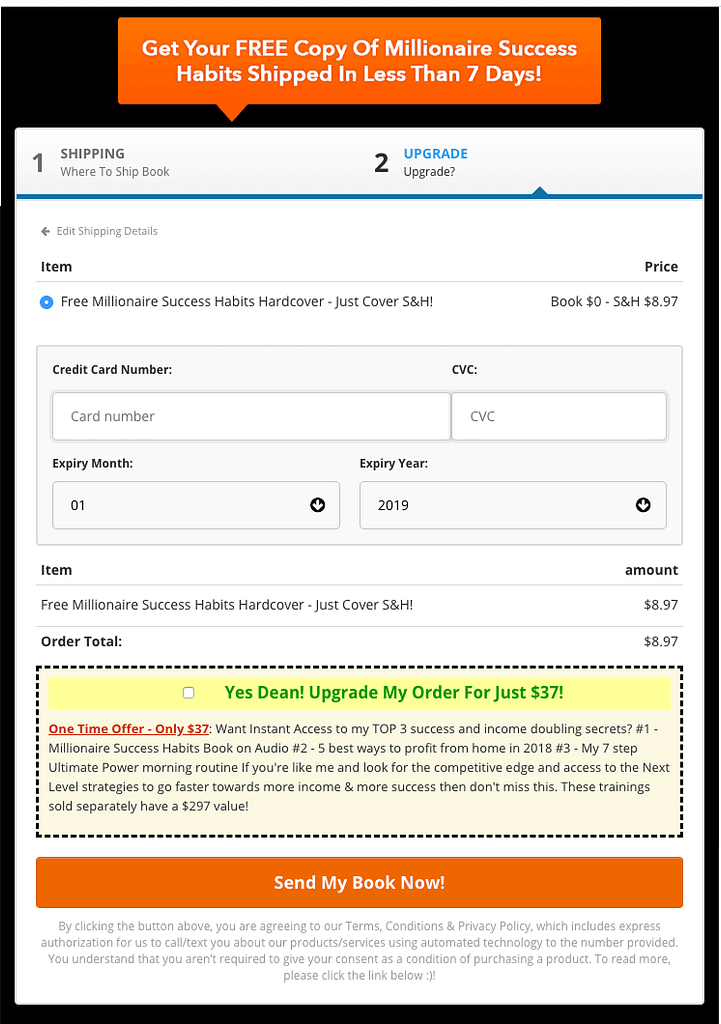
📌 Important: You must clearly mention on the sales page that while the product is free, buyers will be charged for shipping fees. This transparency helps set proper expectations and reduces confusion or cart abandonment during checkout.
This psychology works brilliantly. People are more inclined to complete step one since they aren’t immediately asked for credit card information.
Even if they abandon at step two, you’ve still captured their email address. This allows you to send cart abandonment follow-ups and promote other programs later.
The order bump adds significant value at $37. Customers receive Dean’s top three secrets for success and income growth, including:
- The audiobook.
- The 7 Steps Ultimate Power Morning routine.
- Advanced strategies for increasing income and success.
Placement is critical. A highlighted box with a contrasting color draws attention. The message reads, “Yes, Dean! Upgrade My Order for Just $37,” accompanied by a simple checkbox.
Pricing psychology is spot-on. Compared to the book’s value and bought in retail stores like Amazon ($20 price, excluding shipping), the $8.97 shipping fee feels minimal. The $37 order bump seems like a fantastic deal following the free product.
The checkout form optimization keeps fields to a minimum. Dean requests only essential information, using auto-fill where possible to reduce typing and speed up checkout.
💡 Pro Tip: You can use one-click buyer such as Stripe’s Link, allow prospects to make purchases with a single click or tap by storing their payment information and shipping details for future use. It streamlining the checkout process, reduces the time and effort required for online transactions.
3. Upsell Page That Doesn’t Feel Pushy
A one-time offer (OTO) upsell usually appears right after a customer completes the checkout in a free plus shipping funnel. This is where the real profit come in.
On the OTO page, it’s important to keep the buying momentum going. Instead of just saying, “Thank you for your purchase,” you want to encourage customers to keep shopping.
A well-designed upsell page builds on the customer’s initial decision, increasing the average order value (AOV) by offering something valuable and relevant.
For example, Dean’s upsell page says, “Your order is not yet complete!”
This message motivates customers to stay engaged and consider the next step.
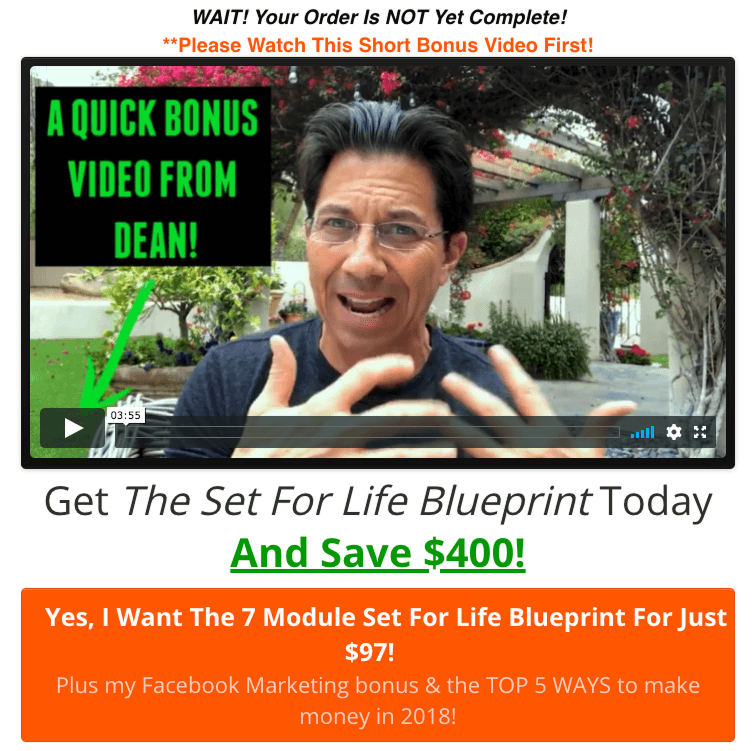
💡 Avoid upselling the exact same product right after the free offer. Customers feel they’ve already solved that problem and might get confused or lose interest. Instead, offer a natural next step.
If someone bought a book on Instagram growth, don’t push another course on the same topic. Instead, offer complementary tools like content design templates, done-for-you service, automation tools or subscription based membership.
Dean’s strategy succeeds because after offering the free physical item (a book about good habits), he presents a marketing training program priced at $97—a logical and valuable next step that aligns with what people need to achieve their goals.
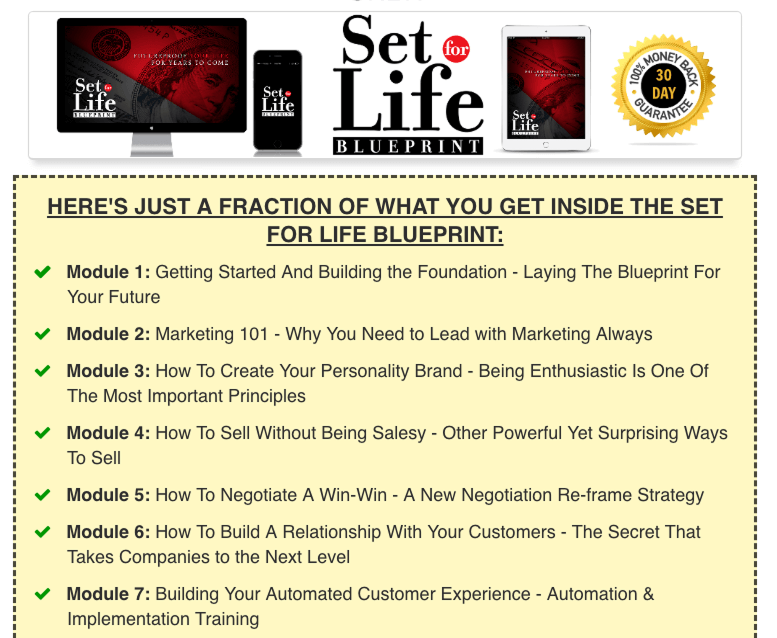
The upsell page includes bonuses like Facebook ads training, ready-made marketing templates, and limited-time live coaching, which add extra value.
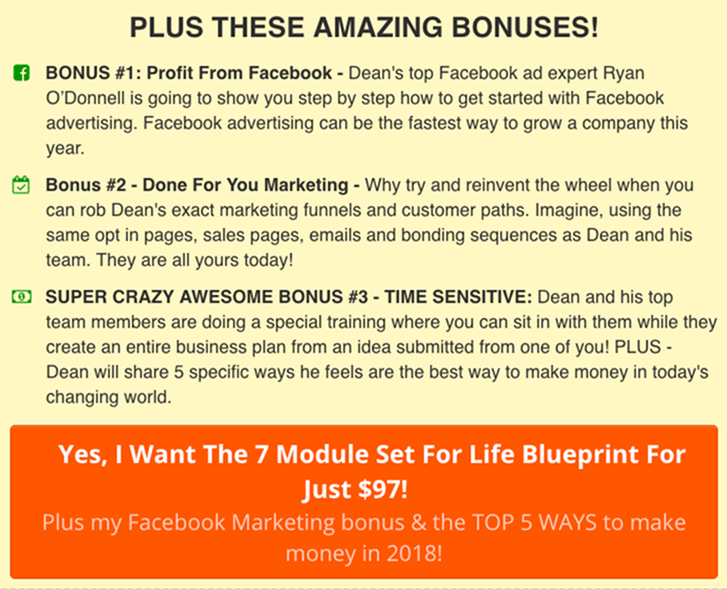
The price feels fair because it’s discounted from $400, and the page uses clear, professional design with videos and testimonials to build trust.
There are no pushy tactics like flashing buttons or countdown timers; instead, urgency comes naturally from the limited-time bonuses.
4. Downsell Recovery Page
If a customer turns down your one-time offer, consider providing a downsell. Here are four effective approaches to structuring your downsell offer:
- Lower the price by removing certain components from the original offer.
- Switch from a physical product to a digital alternative.
- Offer a payment plan to make the purchase more accessible.
- Present a different, lower-priced product as an alternative.
While NOT every sales funnel requires a downsell, it can be a powerful way to boost your average cart value with minimal additional effort.
In our example, Dean’s downsell page grabs attention with the headline: “Wait, Borrow My Money!”
This interruption tactic causes visitors to pause before leaving the page.
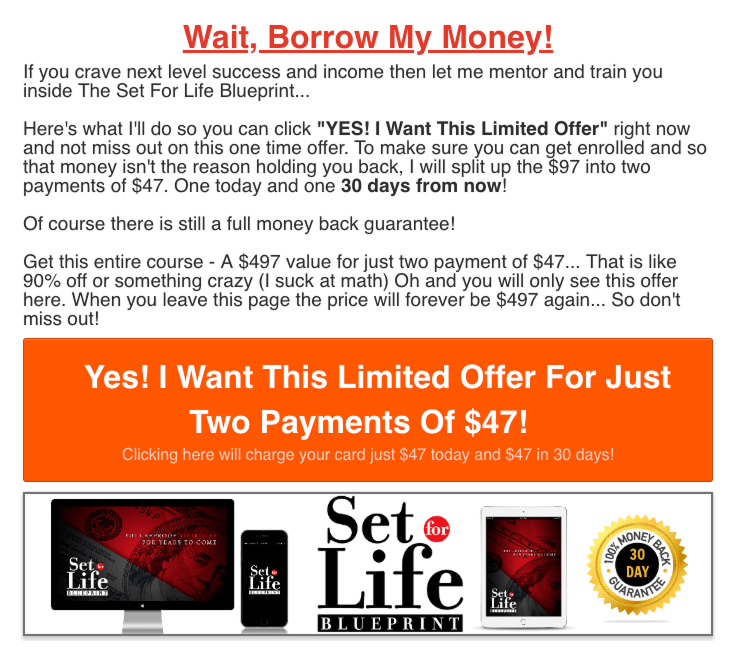
The recovery copy directly tackles what we all know is the main deal-breaker: PRICE.
Two payments of $47? That’s genius – it makes this $97 program totally accessible without making it feel cheap (and trust me, I’ve seen too many marketers mess this up).
Dean really drives home that this is the exact same $497 program… just with payment terms that won’t make your wallet cry.
You’ve got to love the value stacking here – “$497 value for just two payments of $47” keeps hammering home what an incredible deal this is.
The urgency? It actually feels real for once: “When you leave this page the price will forever be $497 again… so don’t miss out.” (How many times have you fallen for that line, right?)
After this page, Dean throws in two more upsells – the Productivity Mastery Training for $47 and the Accelerated Success Formula for $197. Smart move to bump up that average cart value.
The psychological tactics Dean’s using here are pretty much identical to what I covered on the previous upsell page… so I won’t bore you with the same breakdown again.
5. Thank You Page That Builds Long-term Customers
The Thank-You page is the last step in your Free Plus Shipping funnel.
Here, you thank customers for their purchase and give them all the info they need to get their product. It’s also a great spot to invite them to follow you on social media like YouTube, Facebook, or TikTok.
Using a page builder makes it easy to customize this page with personal messages, videos, or calls to action that make the experience more engaging and friendly.
You can also guide customers to the next step in your value ladder.
For example, Dean Graziosi’s thank you page invites buyers to join a free webclass, smoothly leading them toward his higher-priced offers.
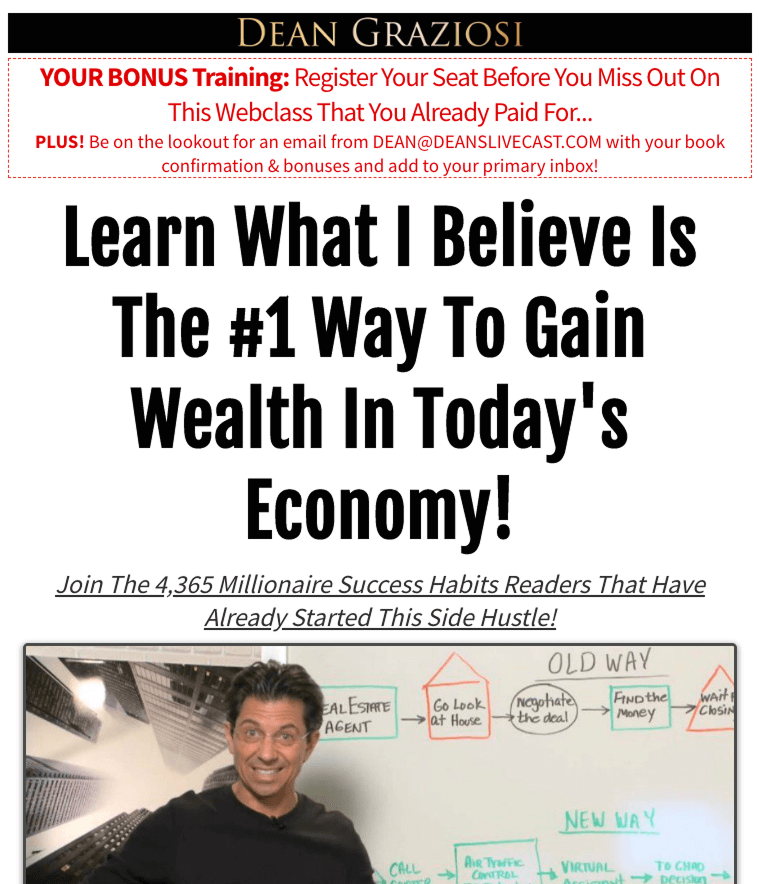
This approach feels natural and helpful, not pushy, because it offers extra free value.
3 Best Tools to Build Your Free Plus Shipping Funnel
Look, picking the right funnel builder can literally save you thousands in development costs and months of hair-pulling frustration – trust me, I’ve been through the trenches testing every major platform out there, and honestly, three just blow the rest away when it comes to free plus shipping funnels.
| Feature | Gohighlevel | Clickfunnels | System.io |
| Starting Price | $97/month | $97/month | $17/month |
| Free & Shipping Funnel Templates | Yes | Yes | Yes |
| Shipping Integration | Shippo | Shipstation and Shippo | Through Zapier and Integrately |
| Number of funnels | Unlimited | Unlimited | 10 |
| Contacts | Unlimited | 10,000 | 5000 |
| 1-Click Upsell | Yes | Yes | Yes |
| Built-in Email Marketing | Yes | Yes | Yes |
| Free trial | 14-day | 14-day | Free plan available |
GoHighLevel is perfect for agencies and advanced marketers. It offers full CRM features, unlimited emails, and strong automation. You can white-label it for clients. But beginners might find it complicated.
Systeme.io is great value for solopreneurs at $17 a month. It includes funnel building, email marketing, and course hosting. Its free plus shipping templates work well but offer limited customization. Ideal for first-time funnel builders.
ClickFunnels 2.0 is the best for conversion-focused funnels. Its templates outperform others consistently. The new version has better analytics, faster loading, and easier mobile editing. The higher price is worth it.
For beginners, start with Systeme.io to test ideas cheaply. Once you grow, upgrade to ClickFunnels for better conversions. Agencies should choose GoHighLevel for scale.
All three platforms connect smoothly with major payment processors and fulfillment services.
4 Common Free Plus Shipping Funnel Mistakes That Kill Profits
Mistake 1: Wrong Product-Market Fit
Choosing the wrong free product can ruin your funnel. Your audience must really want what you offer. For example, a meditation DVD works for stressed executives but not for college students.
Common mistakes include picking products you like instead of what your market wants, assuming digital products on physical media add value, choosing items with no follow-up sales, or offering things cheaper elsewhere.
Do market research:
- Ask your email list what free product excites them.
- Run Facebook polls in groups.
- Test demand with a small ad budget.
Real data beats guessing.
If your landing page converts less than 5%, you likely have product fit (or offer) problems. Bad quality products also hurt backend sales.
Mistake 2: Ignoring Fulfillment Logistics
Handling orders can surprise new funnel builders. Shipping books or products daily is harder than it seems.
When orders grow from 10 to 100+ daily, chaos can happen. Late shipping leads to unhappy customers and more refunds.
Costs add up: shipping, storage, staff, software.
In the US, standard delivery from 3-7 business days. Some customers expect fast delivery like Amazon’s 2-day shipping. Slow shipping causes bad reviews and fewer future sales.
Solutions:
- Use print-on-demand services like Printful.
- Use full-service fulfillment centers as you grow.
- Use tools like ShipStation or Shopify integrations to manage shipping.
Plan your shipping system before launching, not after.
Mistake 3: Weak Upsell Strategy
Bad upsells kill profits fast. Don’t offer random products unrelated to the free item.
Good upsells feel natural:
- Free book → related video course.
- Free necklace → full jewelry set.
- Free supplement sample → larger supply.
Price upsells reasonably: jump from free to $47, then $197, then $497.
Upsells should offer 10x value at each step. Customers buy step-by-step, not big jumps.
Timing matters: offer upsells immediately after purchase to catch excitement.
Poor copy kills upsells. Use strong headlines, social proof, and clear benefits.
Test upsell pages like your main page—they make most profit.
Mistake 4: No Email Follow-Up Sequence
Not following up by email loses money. Email automation is essential to boost sales and customer lifetime value.
Collect emails from free plus shipping offers to market later.
Key email sequences:
- Cart abandonment reminders (recover up to 25% lost sales).
- Upsell follow-ups (convert unsure buyers).
- Next funnel promotions (keep customers engaged).
Use a 3:1 ratio: three helpful emails for every sales email to avoid annoying subscribers.
Segment your list by behavior and purchase type for better results.
Automation tools like ClickFunnels, ActiveCampaign, or ConvertKit make this easy and profitable.
Is Free Plus Shipping Right for Your Business?
When Free Plus Shipping Works Best
Free plus shipping funnels work really well when set up the right way. They are great for coaches, course creators, and info-product sellers—especially if you’re giving away something like a book or a small sample that costs little to make but feels valuable to your target audience. E-commerce brands also use this method to build their buyer lists by offering accessories or trial-size products.
Here’s what makes a product perfect for this model:
- Costs less than $5 to produce
- Weighs less than 1 pound (so shipping stays cheap)
- Has a high perceived value (prospects think it’s worth over $20)
- It is easy to sell more expensive products later (upsell opportunities)
Think about items like books, small tools, or product samples. Big, complicated, or expensive products usually don’t work well with this funnel.
This funnel works best in competitive markets where customers care about price. It’s especially good for business-to-consumer (B2C) markets, where shoppers are used to seeing “free” offers, like on Amazon.
What You’ll Need to Get Started
Running a free plus shipping funnel isn’t actually free—you’ll need some investment upfront and ongoing effort.
Expect to spend:
- $2,000 to $5,000 to buy your initial inventory and set up your funnel
- $1,500 to $3,000 per month on advertising (ad spend)
- Around 10 to 20 hours per week at first (less once things are automated)
Having a virtual assistant (VA) can help, but you can start on your own. You’re probably ready if you have:
- An email list of at least 1,000 people
- Clear demand for your product or topic
- Good offers to sell after the free product (backend offers)
- Basic skills to build funnels or a strong desire to learn
If you don’t have all these yet, that’s okay—it just might take more time and work.
When to Avoid This Funnel
Some businesses should avoid free plus shipping funnels because they don’t fit well.
- Service providers who don’t sell physical products will find it hard to offer something free plus shipping.
- Digital-only businesses lose money because they have to pay for physical shipping they don’t need.
- Local businesses usually don’t benefit unless they can ship products nationwide.
Also, if your market is crowded with competitors all offering free books or samples, the tactic may not work well anymore.
Industries with strict advertising rules, like finance or health supplements, might find it hard to scale this funnel.
International businesses face challenges like high shipping costs and customs paperwork.
If you have limited money (under $2,000) or no way to handle shipping and inventory, other funnel types might be better.
For example, webinar funnels work well for selling expensive products, video sales letter (VSL) funnels suit digital products, and application funnels help qualify serious buyers.
Challenge funnels help build community while selling.
Choose the funnel that fits your business strengths and resources.
Warning Signs to Skip Free Plus Shipping
You should probably avoid free plus shipping if:
- Your product costs more than $10 to make and ship
- You don’t have good products to sell after the free offer
- You dislike managing physical inventory and shipping
- Your audience expects everything for free all the time, or competitors have given bad experiences that hurt trust

John R. Bryant
John R. Bryant, founder of Living With Funnel, is a funnel building expert and digital marketing strategist with over 10 years of experience. Specializing in conversion optimization and funnel building. His expertise in lead generation, email marketing, and CRM systems drives client success through increased conversion rates and optimized marketing automation.
Continue Learning With These Topics

